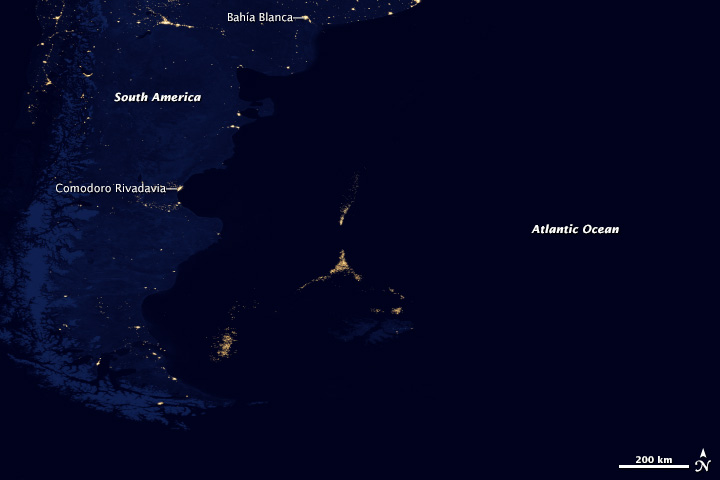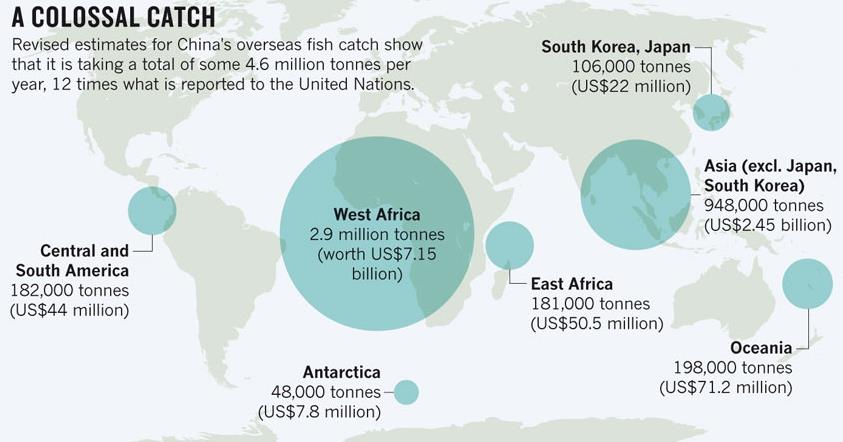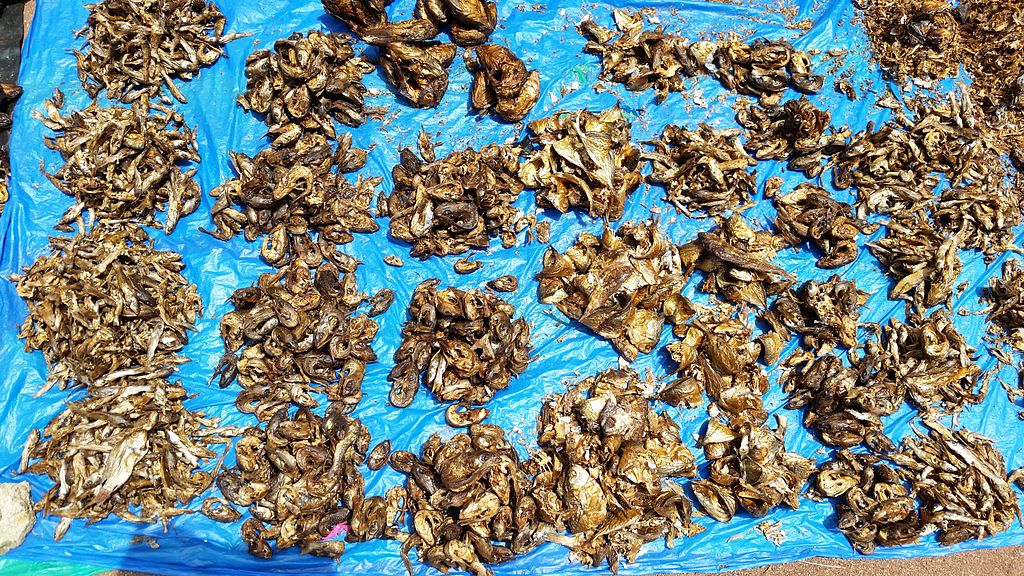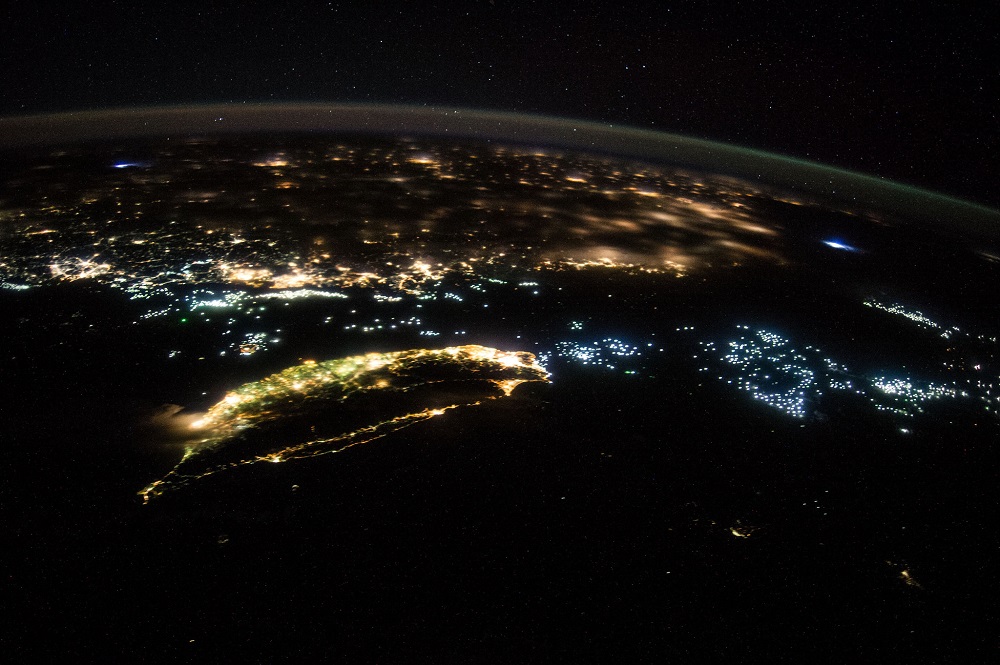- China is the largest consumer, producer and exporter of fish, with a distant-water fleet operating in 93 countries.
- But Chinese boats are routinely getting into scuffles with foreign authorities for fishing illegally in their waters.
- Analysts say government subsidies and poor oversight promote overfishing and rogue activity.
From space, there is only one stretch of ocean that lights up at night, in spring.
Breaking the dark in a curved line near South America’s southern tip, the lights beam from hundreds of boats hunting for Argentine squid (illex argentinus), one of the most commercially fished of the species.
Much of the haul here is sanctioned, carried out by ships licensed by the Argentine or Falkland Islands governments.
Increasingly, however, the illicit catch is outshining the legal one — with Chinese boats at the center of the plunder.
On March 15, one such ship, the Chinese Hua Li 8, was arrested by the Indonesian Navy six weeks after it dodged Argentine and Uruguayan patrols en route to international waters. The squid jigger had been blacklisted by Interpol for poaching. The following day, another Chinese ship suspected of poaching was sunk by the Argentines.
The two episodes are not isolated incidents. They are part of a string of confrontations from South Africa to Indonesia to New Zealand — aggressions made all but inevitable by China’s unprecedented, decades-long fishing push into foreign waters.

In the disputed waters of the South China Sea, mitigating the risk of a militarized fight for fishing rights has emerged as the primary concern.
Farther away, however, concerns tend to focus on the stress China’s growing distant-water fishing (DWF) fleet exerts upon global fisheries already stretched to the breaking point.
Emperor of the sea
Since 1985, China has grown from a bit player in the world’s fisheries into far and away its most dominant force.
Today, the country — whose annual catch of some 15 million tons makes it the world’s top fisher twice over — commands a chart-topping DWF fleet of 3,400 ships spread over 93 countries.
By comparison, the U.S., the world’s third-largest fisher, maintains just 200 ships.

According to a report by the U.S.-based Wilson Center, the DWF build-out was catalyzed by a nearly 50% collapse in China’s own domestic fish stocks.
Simultaneously, the country booked a 600% rise in per capita seafood demand, and emerged as the world’s largest seafood exporter in 2012.
The resulting sprint to tap foreign fisheries has environmentalists vexed, as the global fleet is already 2-3 times larger than what oceans can sustainably support. At the current rate, “stocks of all species currently fished for food are predicted to collapse by 2048,” the World Wildlife Fund (WWF) has reported.
“While a handful of other countries maintain sizable DWF fleets, China’s is so large and their policies so weak that the impact is disproportionately large,” American University fisheries analyst Chris Carolin told Mongabay.
“In effect, China’s own coastal environmental insecurity and lack of effective oversight is now being exported globally,” he added in a recent article.

Though China’s fishing operations stretch around the globe, they are concentrated in the exclusive economic zones (EEZs) of just a handful of developing nations.
Under the 1982 United Nations Law of the Sea (UNCLOS), developing nations are allowed to lease fishing rights within their 200-mile EEZ to richer countries like China.
In exchange, China usually offers something in return — generally, sweetheart infrastructure deals or discounts on wild-caught fish. The arrangements, however, create harmful power imbalances and promote illegal, unreported and undocumented (IUU) fishing.
A 2012 study found the contracts fostered host-nation dependencies that constrained their ability to enforce violations. The same study observed that unlike other DWF nations, China kept the terms of its EEZ contracts secret.
Using unofficial documents and port data, the authors concluded that from 2000-11, Chinese DWF boats hauled in an average of 4.6 million tons of fish a year — over 10 times what the country had been reporting to the UN’s Food and Agriculture Organization (FAO).
“The activities of the Chinese distant water fleet are almost completely undocumented and unreported,” the authors concluded, “…and may actually be illegal, spanning the entire gamut of IUU fishing.”
Africa: the golden goose
The IUU menace is especially severe in West Africa, a region that has fast become the apple of China’s eye.
According to the EU report, China extracts over two thirds of its DWF haul from the EEZs of West African nations like Senegal, Gambia and Guinea — the vast majority of it unreported.
“A first-order estimate of potential IUU around the Africa region shows around 2.5 million tons per year, of the estimated Chinese DWF catch of about 3.1 million tons in the African region, may be unreported.”
By EU estimates, in other words, from 2000-11, China’s reported catch of 368,000 tons amounted to just 15% of its total unreported catch from West African waters alone.


Though a hefty portion of the unreported haul was probably fished unlawfully — either in quantities that surpassed contract quotas or via rigs like bottom trawlers that kill marine life indiscriminately — the opacity of the contracts and the weakness of monitoring make it impossible to know the precise percentage.
Whatever the scale, however, the effect on sustainability is glaring: according to the Global Ocean Commission, the situation in West Africa is “particularly grim,” with 53% of fish stocks overexploited and 43% fully exploited; only 4% of fish stocks are being fished at sustainable levels.
The overfishing has also been blamed for a shortage of seafood available to populations in coastal West Africa, triggering protein deficits likely to last for generations to come.

From 2000-06 and 2011-13, according to a 2013 Greenpeace study, there were 183 documented IUU fishing cases in six West African countries — Gambia, Guinea, Guinea-Bissau, Mauritania, Senegal and Sierra Leone — all of which involved Chinese-owned or flagged vessels.
“At least 31% of them have engaged in illegal fishing activities more than once. Most of these vessels are bottom trawlers, one the most destructive fishing vessels in the industry,” authors wrote.
Subsidy scourge
Without government subsidies in the form of fuel, tax breaks and ship upgrades, experts say China’s DWF in Africa and elsewhere would be unprofitable, thus raising the question: is the Chinese government willfully underwriting the plunder?
According to Carl Thayer, an Asian security expert at University of New South Wales, such a claim would be a stretch.
“While China, particularly its provincial governments, subsidize their fishing fleet and provide subsidies based on engine size, I do not think the Chinese state directly encourages illegal fishing,” he told Mongabay.
Siddharth Chakravarty of the marine conservation group Sea Shepherd said regardless of intent, the problem of accountability remained.
“The failure of China to monitor its foreign fleet means the subsidies end up being used for poaching operations…and given the scale of China’s distant-water fishing fleet, the extent and effect of the misuse and misappropriation of the subsidies would be big,” he told Mongabay.

Analysts agree that China’s capacity-boosting subsidies are a big driver of maritime degradation.
In her latest study of Chinese fishing subsidies, Tabitha Mallory of the U.S.-based National Bureau of Asian Research found that 95% of the $6.5 billion doled out in subsidies in 2013 promoted overfishing, harming marine ecosystems. The lion’s share of the damage, she found, stemmed from fuel subsidies.
The harm lies also in how giant subsidies alter the market value of seafood products.
According to American University’s Carolin, “the subsidies artificially lower the value of a single fish, thus driving an increased effort to catch more, and creating a higher overall demand due to the low market price.”
Eyes on China
Despite China’s outsize impact, Mallory says improving fisheries management should be seen as a “collective action problem to which we all contribute” — especially because a major driver of Chinese IUU fishing is rising demand in the U.S., the EU and a handful of other countries.
“China has long served as the world’s factory, which means China is not only looking for resources for its own needs, but satisfying the resource-based needs of much of the developed world as well,” Carolin told Mongabay.
“After all we all want cheap furniture, or cheap boneless fish fillets — and much of that comes from China.”
According to the Global Ocean Commission, while the Chinese government has passed some praiseworthy conservation policies at home, it routinely obstructs sound management of the fisheries it exploits abroad, practicing a “near complete disregard for public accountability for the use of public resources.”
The FAO projects China’s share of wild fish capture will hold at around 17% for the next 15 years. As such, experts say that that while coordination among smaller global actors is key to ensuring maritime sustainability, China’s collaboration remains indispensable.

Acquiring that cooperation, however, will rely on countries like Indonesia bringing pressure to bear.
“More and more countries in the developing world are starting to take this problem very seriously, and as we can see in Indonesia — where the military is actively hunting and sinking illegal fishing vessels — or in Palau — where they are really beginning to crack down — governments are standing up and fighting for healthy fisheries,” Carolin said.
“Time will tell, but there will likely be some more fisheries collapses before China’s DWF fleet is truly reigned in.”
Follow Cory Rogers on Twitter: @cm__rogers













